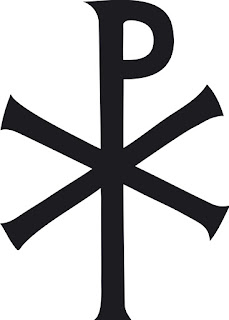For more than 1600 years, the "Cross" has been the most recognizable symbol of Christianity. But this was not so in the first few hundred years after Jesus Christ, around 30 and 33 CE. Rather than the cross, the earliest Christian symbol used on coins was the superimposed Greek letters chi (X) and rho (P) and represents the first two letters of Christ in Greek. This type of monogram is called a Christogram.
The immediate cause for the adoption of the Christogram is said to have been the vision of Constantine before the battle at the Mivian Bridge in 312 AD.
In the battle the symbol was written on the shields of soldiers, but soon Constantine gave it a wider use by decorating his helmet with it.
Silver medallion from Ticinum depicting Constantine wearing a battle helmet with a small chi-rho in the central roundel, 315 CE (image courtesy State Hermitage Museum)
On this Medallion Constantine wears a helmet crested with peacocks' feathers and a Christogram within a circle in front and a shield with the Capitoline Wolf, the symbol of Rome. This is the oldest representation of the cypher in a military context (315 AD). The combination of the Christogram and the Capitoline wolf meant "Christian Roman Army".
The first type to refer to Christianity was struck in 327-328 AD, under Constantine. It has provoked many scholarly articles. This coin must have been very unpopular when it was issues in 326 AD because it was almost immediately discontinued. 'SPES' means "hope" and had appeared on coins earlier too. But a snake, interpreted as a symbol of evil, with the head of the snake drooping is interpreted to Constantine who talked about serpent as the Devil.
Constantine, 327-328 AD, weight 2.9 gm
Obverse: Constantine head right
Reverse: SPES PVBLIC across the field with A in the lower left field and chi-rho topping a standard with three dots on the vexillum planted in a serpent with head downwards.
The first fully Christian design. Magnentius (350-353 AD) issued a coin in the chi-rho type. Not only is the chi-rho a Christian reference, but so is the alpha (A) and omega (w) pair. Alpha is the first letter in Greek alphabet and omega is the last. In the book of Revelation (1:8) it says, 'I am the alpha and the omega, the first and the last, and it refers to Jesus.
The first overtly Christian legend. In 350 AD, the first type with an overtly Christian legend occurs. Vetranio, ruler in the Balkans during the reign of Constantius II, issued the one with the legend "HOC SIGNO VICTOR ERIS" referring to " the sign "you will be victorious", the vision of Constantine prior to the battle of the Milvian bridge on October 28, 312 AD. This had shown a standard with a chi-rho, called a labarum.
Chi-rho on the shield. Crispus was the first son of Constantine and was executed in 326 AD. This coin struck in 322-323 AD, depicts a bold chi-rho symbol on the shield held by Crispus.
Christian Symbols. There were four Christian symbols on the Roman coins of the fourth century. The chi-rho, cross (square of long), cross-rho and the hand of God (without and with wreath).
Cross
Hand of God. It first appeared on coins after the death of Constantine in 337 AD on a "deification" issue struck by his sons.
Later after Christianity was well established, a coin of Arcadius, struck in 383, has a clear hand of God holding wreath crowning the emperor.
Eyes to Heaven. This type was interpreted by ancients as Christians and were struck in 328 AD. The head is tilted backwards which allows him to look upwards towards heaven.
The Cross type. In the 5th century it was common to have a cross on the coins
Numerous Byzantine rulers featured crosses on their coins. A gold coin of Tiberius II Constantine (578-582 AD) showed the emperor holding a scepter surmounted by a cross.
The first portrait of Jesus was used on a coin struck in 692 AD, under Justinian II. This was about 300 years after the Christian Cross began to appear on Roman coins.























Excellent information on chi-rho, Alpha Omega and on ancient Christian symbols. Gen Rajeev, super effort
ReplyDelete